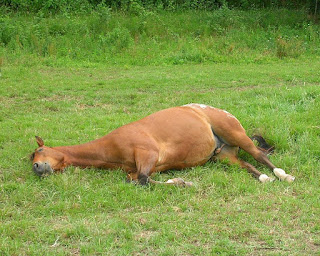Although not a disease or illness
fly bites cause considerable distress to horses, ponies and donkeys. The effect the bites have vary from horse
to horse, some will be largely unaffected but some will develop a swelling
around the area of the bite and some can have an allergic reaction.
What are they
Flies bite and pierce the skin,
they then feed on the horses blood. They can also carry disease and infection
between equines! Flies are attracted to blood,
saliva, tears and mucus and so tend to be found around the eyes, nose and
mouth, around the sheath or any wound and any other softer more sensitive areas
of skin. As mentioned earlier the effect
the bites have varies from horse to horse but the effect will also vary
depending on the type of fly which delivers the bite.
Flies and mosquitoes are more
active when it is hot and are generally attracted to water.
This horse has lots of little bites.
Chesney developed this huge lump after he was bitten last summer!
Signs
Horse Flies: The bites are small
lumps which have an ulcer in the middle.
The bites are painful and itchy.
Black Flies: Their saliva causes
an allergic reaction which results in painful lumps which have tiny areas of
bleeding.
Midges: These are the nasty
little ones that cause sweet itch - I wrote a separate
blog about this some time ago!
Bots (Warble Flies): Bite is
painful and they leave their eggs on the horse's body.
In a horse with a serious
allergic reaction you should look out for:
- Fast and
heavy breathing
- Elevated
heart rate and temperature
- Standing
with head low
- Lethargy
- Severe
swelling
Treatment
- If the horse
is having a severe allergic reaction call the vet.
- Ice packs or
bathing the bite with cool salt water can give some relief. Alternatively, washing the area with a horse
shampoo will cool the skin.
- Bot flies
can be removed with a special 'knife'
Prevention
- Physical
barriers like rugs and hoods are a good option.
- Use a fly
spray on the horse.
- Specific
sprays are also available to spray the stables.
- Ensure there
are no areas of stagnant water which is where midges breed .
- Horse Flies
don't like dark areas so stabling offers some relief from these.
- Black Flies
don't like citronella so using a fly repellent containing this should stop this
type of fly landing on the horse.
- You
should worm your horse against bots in the winter.
Flies are a nuisance and can
cause misery! I bring my horses into the
stables in the daytime during the summer to get them away from the horse flies.
Have you seen this week's video 'One Day in May 2016' on my You Tube channel.
Horse Life
and Love. Please check it out and SUBSCRIBE.
You can also follow me on Facebook and
Instagram for updates on Chesney, Basil, Tommy and Daisy.
Until next time!
Jo
























